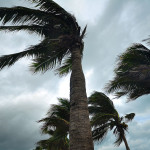

A Pacific storm will dump heavy rains across drought-stricken Southern and Central California, threatening the area with mudslides and floods.
The storm will also leave snow across the Sierra Nevada mountains that may provide a start toward recharging the region’s water supplies for next year’s growing season.
Flash flood watches stretch from Santa Barbara to the border with Mexico, including Los Angeles and San Diego, through early tomorrow, according to the National Weather Service.
“It’s their rainy season so it’s not uncommon for California to get heavy rains,” said Bob Oravec, a meteorologist at the U.S. Weather Prediction Center in College Park, Maryland. “The heaviest rain is going to be today.”
 The areas scarred by fires in Los Angeles and Ventura counties earlier this year will be particularly vulnerable to landslides, the weather service said. Without vegetation to hold the soil in place, it can be easily washed away by the rain. In addition, parts of the Santa Monica mountains also face a threat.
The areas scarred by fires in Los Angeles and Ventura counties earlier this year will be particularly vulnerable to landslides, the weather service said. Without vegetation to hold the soil in place, it can be easily washed away by the rain. In addition, parts of the Santa Monica mountains also face a threat.
“Southern California residents in or below the recently burned areas are urged to take the steps necessary to protect their property,” the agency said. “Persons in the watch area should remain alert and follow directions of the emergency preparedness officials.”
Gusty winds are also forecast for many parts of Southern California, which may make it difficult for trailer trucks on roads including highways 1 and 101, the weather service said.
Second Storm
The system is the second of two storms that have struck the state since the weekend. More than 1 inch of rain (2.5 centimeters) fell around San Francisco, with more in the mountains, causing slick roads and downing some trees and power lines, the weather service said.
The Bay Area is also forecast to get heavy rain from the new system.
The storm will be at its strongest along the coast, although there is a chance that heavy snow will fall in the Sierra Nevada. A winter storm warning stretches from Burney in the north through Sequoia National Park in the south, the weather service said.
Snow amounts may reach 2 to 3 feet at the highest elevations. California depends on its winter snowpack for much of its water throughout the year.
“That is very important for the water budget,” Oravec said.
Almost 100 percent of the state was in moderate to exceptional drought as of Nov. 25, according to the U.S. Drought Monitor. Rain and snowfall have been below normal for three years and the latest storms won’t be enough to replenish reservoirs. Officials have estimated it will take 2 1/2 times the normal seasonal snowfall to break the drought.
Oravec said the storm will move inland, weakening as it goes, and spread rain throughout Nevada and Utah in coming days.